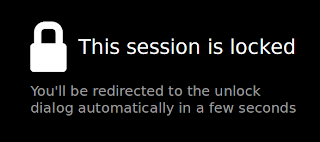Light Locker is a new session locker for LightDM forked from GNOME Screensaver (3.6.1). The tool doesn't have any desktop-specific dependencies and it locks and unlocks the session via ConsoleKit / UPower or logind / systemd.
Currently, if you try to lock the session using LightDM via Dbus (so without Light Locker), you can still access your unlocked session via Ctrl+Alt+F7. Instead of this, Light Locker displays a message saying that the session has been locked and after a few seconds it displays the unlock dialog (LightDM):
According to Simon Steinbeiß, one of its developers, Light Locker might make it into Xubuntu 13.10. elementary OS is considering using Light Locker as well. But until then, the tool needs testing so if you can help, give it a try by using the instructions below.
In my test under Ubuntu 13.10 Saucy Salamander, the locker didn't work too well: while I was able to successfully lock the screen via the lock command (and a keyboard shortcut I've assigned), the screen didn't lock after resuming from suspend, probably because it lacks the scripts to lock the session on suspend and hibernate.
For a bit more about Light Locker, see Simon Steinbeiß's post.
Test Light Locker
If you use Ubuntu 13.10 (Saucy Salamander), you can install Light Locker by using the following commands:
sudo add-apt-repository ppa:light-locker/release
sudo apt-get update
sudo apt-get install light-lockerThere's also a daily PPA but the pakages from this PPA are empty so you shouldn't use it for now.
To test Light Locker, run the following command in a terminal:
light-lockerlight-locker-command -lLight Locker should now be used instead of GNOME Screensaver for locking the screen (when using the session menu, closing the laptop lid, etc.). There's no need to do anything else because after a log out, Light Locker will be started automatically.
Optionally, to lock the screen via a keyboard shortcut using Light Locker, add a custom command for "light-locker-command -l" and assign it a keyboard shortcut (if you want to assign it the default shortcut, change the default to something else, then assign that shortcut to the "light-locker-command -l").
If you want to go back to using GNOME Screensaver for screen locking, simply remove Light Locker:
sudo apt-get remove light-lockerReport any issues you may find @ GitHub.


0 comments:
Post a Comment